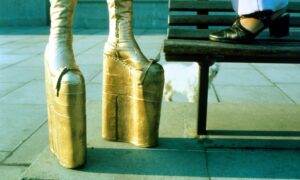
“In a world governed by ideal economic conditions … there will be no sensible shoes,” 1920s shoe designer André Perugia once said. We’re all wearing comfy, sexless trainers now, so draw your own conclusions. Thankfully, history has plenty of silly footwear at hand to amuse us, while we wonder where all our money went.
Paleoanthropologists can tell when we started to wear shoes regularly by looking at feet: toe bones became spindlier about 40,000 years ago. Most of that footwear was too organic to survive. The oldest known example is a pair of sagebrush bark sandals that are probably about 10,000 years old and look like something many Guardian readers would wear; while Ötzi the iceman had a chic-er pair in 3300-ish BC, with a bearskin base, deerskin side panels, and a bark-string net to pull them closed. “The thick layer of hairs gives good insulation and a soft feeling to walk on,” a researcher who reconstructed them commented, which sounds like a four-star review to me.
If you’ve read other Shock of the olds, you won’t be surprised to hear that the Greeks, Romans and Egyptians were all over shoe tech. You can buy sandals that look like many-thousand-year-old Greek ones with a toe and ankle strap, and Tutankhamun’s tomb contained exquisitely decorative purple and gold “thebets”, a sort of flip-flop.
As Tut’s sandals show, shoes were about more than not treading on painful or potentially fatal stuff almost from the beginning. They were a way to convey status, look bigger and more powerful, or to attract a mate. Men’s shoes were as fancy as women’s, historically: “licentious spendthrift” Richard Sackville’s 1613 portrait features gigantic rosettes on his white heeled slip-ons (Jacobean playwright John Webster poked fun at using “overblown roses to hide your gouty ankles”). Short king Louis XIV (5 ft 4/162cm) displayed permanent eleganza in his towering red heels, which Charles II copied.
